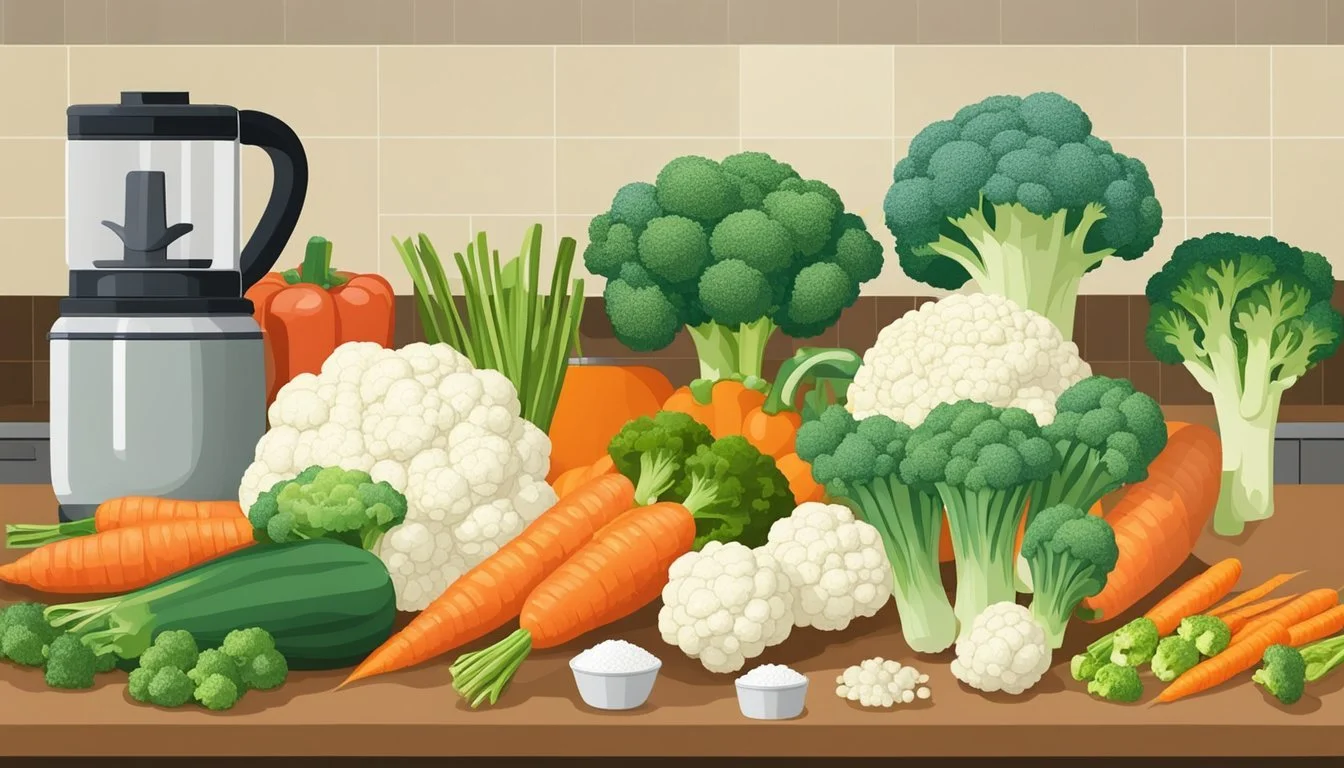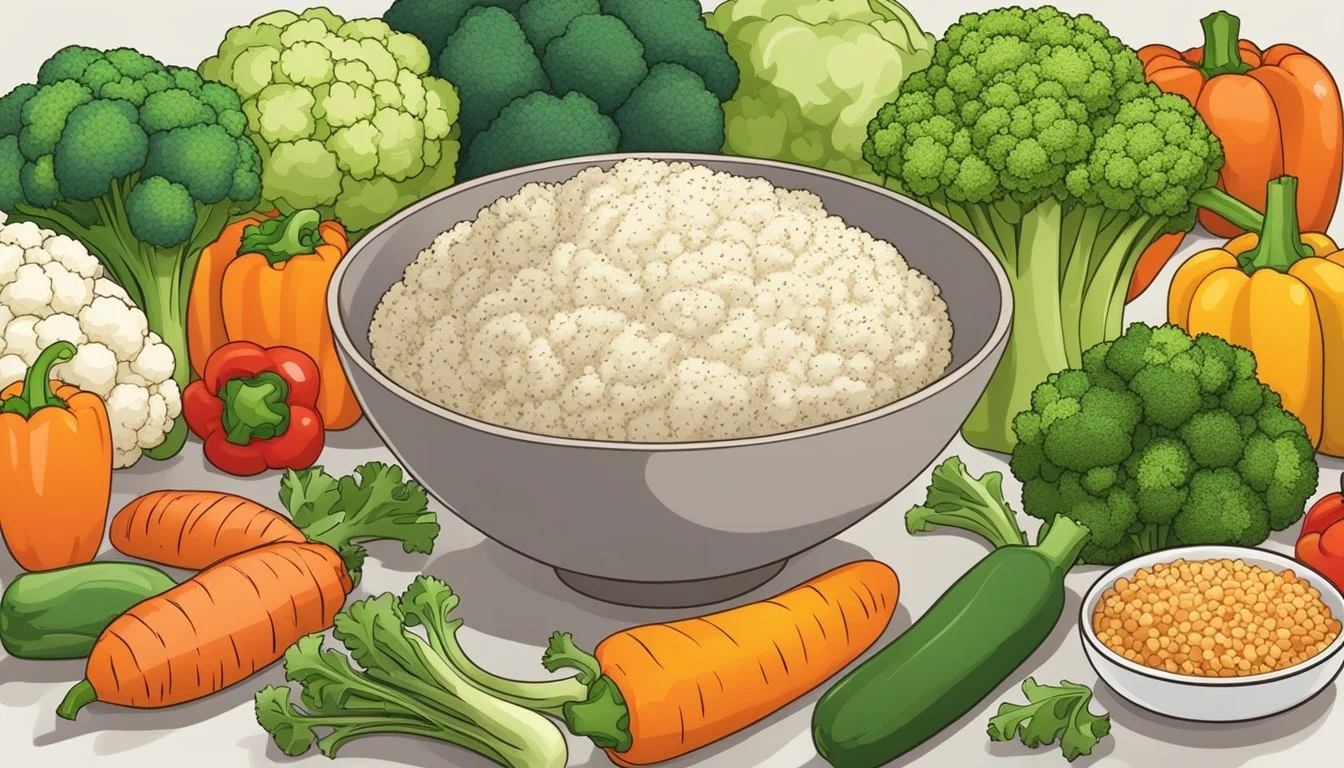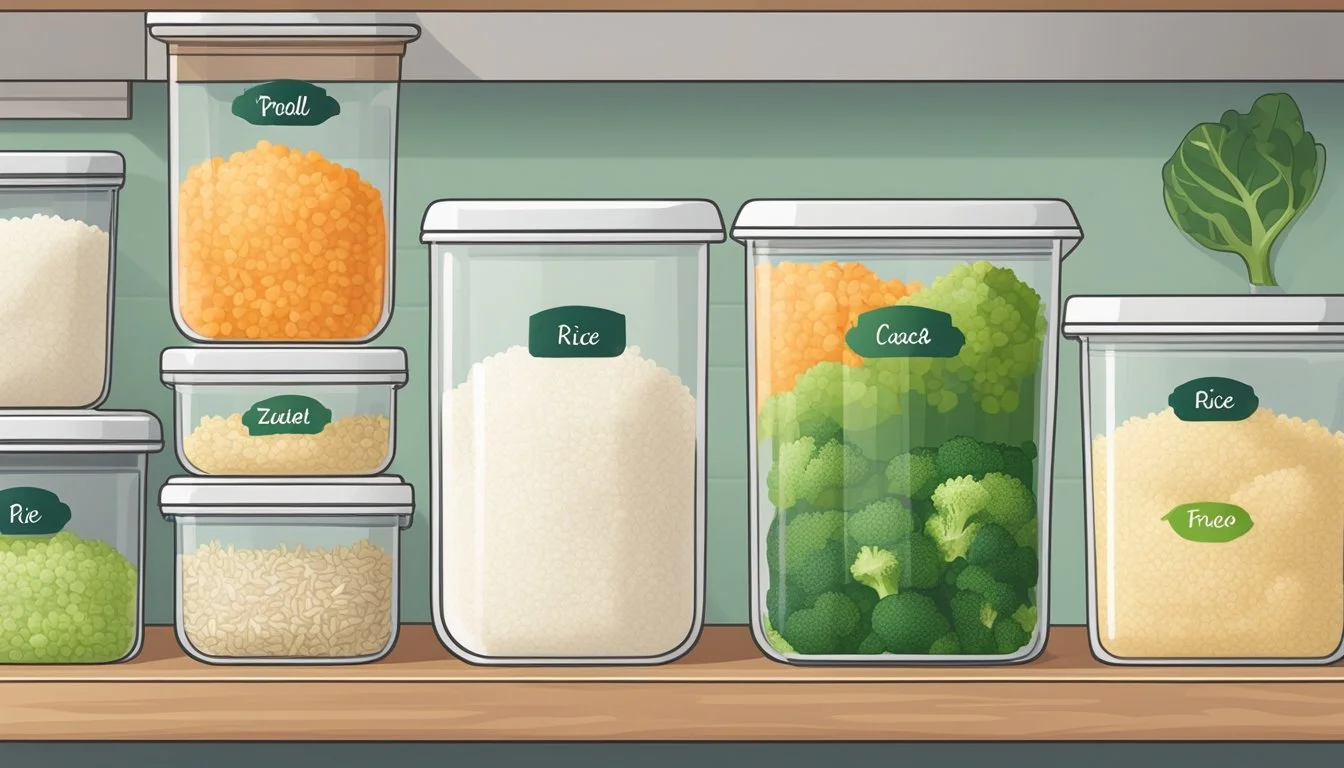Cauliflower Rice Substitutes
Top Alternatives for Low-Carb Diets
Cauliflower rice has emerged as a popular rice substitute for individuals looking to decrease their calorie and carbohydrate intake without sacrificing the satisfaction that comes from a hearty grain dish. Made by grating cauliflower into small, rice-like grains, cauliflower rice offers a neutral flavor that easily adopts the seasonings and herbs with which it’s cooked. With only about 13 calories per half-cup serving, it stands in stark contrast to white rice, which contains approximately 100 calories per the same serving size.
Not only does this rice alternative cater to low-calorie diets, but it's also well-suited for those seeking a low-carb option. Its versatility has made it a staple in gluten-free, paleo, and keto meal plans, boasting a nutrient-dense profile that serves as an excellent base for a variety of dishes. Typically, cauliflower rice doesn't require boiling as traditional rice does and can instead be sautéed or steamed to achieve an al dente texture.
For those not accustomed to the mild flavor of cauliflower or looking for variety, there are whole-grain and vegetable options that offer a range of flavors and textures. Whole-grain substitutes like bulgur wheat, couscous, and farro, though not gluten-free, are hearty and nutritious, packing a blend of vitamins, minerals, and fiber. Other vegetables commonly used as rice alternatives include chopped and seasoned broccoli stems or diced sweet potatoes, each adding their own unique flavor and nutritional profile to meals.
Benefits of Cauliflower Rice Substitutes
Cauliflower rice serves as an excellent low-calorie and low-carb alternative to traditional rice, boasting a rich nutrient profile suitable for a variety of dietary preferences.
Low-Calorie and Low-Carb Options
A serving of cauliflower rice typically contains significantly fewer calories and carbohydrates than an equivalent serving of white rice. For example, a 1/2-cup serving of riced cauliflower contains just around 13 calories and 2-3 grams of carbs, compared to the 100 calories and 22 grams of carbs found in the same serving of white rice. This makes it a favored option for individuals following a keto or low-carb diet.
High Nutritional Value
Cauliflower rice is not just low in calories and carbs; it's also high in nutritional value. It is a source of fiber, vitamins such as Vitamin C and K, and essential minerals including potassium and manganese. Additionally, the presence of antioxidants helps protect the body against harmful free radicals.
Nutrient Benefit Fiber Supports digestion and satiety Vitamins Essential for overall health maintenance Minerals Important for bone health and metabolism Antioxidants Combat oxidative stress
Suitable for Different Diets
Cauliflower rice is highly versatile and adapts well to various dietary restrictions. It is naturally gluten-free, making it a suitable grain substitute for those with celiac disease or gluten sensitivities. Being a plant-based food, it also fits into vegetarian and vegan diets. Moreover, its compatibility with paleo dietary guidelines allows it to be integrated into meals that focus on whole, unprocessed foods.
Cauliflower Rice Cooking Techniques
Transforming cauliflower into a versatile, low-carbohydrate rice substitute involves simple yet varied techniques. Each method provides a different texture and convenience level, capable of catering to the cook's preference or specific recipe requirements.
Using a Food Processor
The food processor stands as the quickest way to turn a head of fresh cauliflower into a rice-like consistency. Cooks can:
Cut the cauliflower into evenly sized florets.
Pulse in batches to avoid overcrowding, yielding uniformly sized grains.
A food processor ensures a fine, consistent grain suitable for a variety of dishes, from stir-fries to salads.
Manual Ricing with a Grater
For those without a food processor, a grater offers a hands-on approach. To manually rice cauliflower, one must:
Use the medium holes of the grater to grate florets.
Apply firm pressure for best results, yielding a coarser texture than that of a food processor.
This method may take longer but it allows for greater control over the texture of the cauliflower rice.
Pre-cooked Frozen Alternatives
Frozen cauliflower rice is a convenient, time-saving alternative to fresh, requiring no ricing. To prepare:
A microwave can swiftly cook the rice directly in its bag, depending on the product's instructions.
Alternatively, to enhance flavor, sauté from frozen in a hot skillet.
Frozen cauliflower rice provides an efficient, ready-to-cook option for those seeking convenience without sacrificing the health benefits of cauliflower.
Popular Cauliflower Rice Substitutes
For those looking to reduce carbohydrate intake or add variety to their meals, several vegetable-based alternatives to traditional rice have gained popularity. Each offers a unique flavor profile and textural difference, making them suitable for a range of dishes.
Broccoli Rice
Broccoli rice presents a nutritious alternative to riced cauliflower. It is created by pulsing raw broccoli florets in a food processor until they resemble the size and texture of rice grains. Riced broccoli retains its vibrant green hue upon cooking and provides a slightly more robust flavor compared to its cauliflower counterpart.
Shirataki Rice
Also known as miracle rice, shirataki rice is derived from the konjac root and is composed predominantly of a water-soluble dietary fiber called glucomannan. This rice substitute is very low in calories and carbohydrates, and it mirrors the texture of traditional rice, albeit with a slightly chewier bite.
Zucchini Rice
Zucchini rice is crafted by grating zucchini or processing it in a food processor until it obtains a rice-like consistency. It is highly versatile, quickly absorbing flavors from herbs, spices, and sauces, making it excellent for stir-fries and pilafs where it can showcase these elements effectively.
Sweet Potato Rice
Lastly, sweet potato rice is yet another wholesome substitute. To achieve a rice-like texture, sweet potatoes are grated or processed into small, rice-sized pieces. As the name suggests, this substitute offers a subtly sweet flavor and robustness that holds up well in hearty recipes like burrito bowls and warm salads.
Grains and Legumes as Substitutes
For those looking to diversify their diet, grains and legumes offer excellent alternatives to cauliflower rice. This section examines four nutritious substitutes that are rich in protein and fiber - each providing unique benefits.
Quinoa: A Complete Protein Source
Quinoa is known for its status as a complete protein, meaning it contains all nine essential amino acids. One cup of cooked quinoa offers approximately 8 grams of protein, making it a robust alternative to traditional rice. It's also gluten-free and can act as a versatile base in a variety of dishes.
Lentils: Rich in Fiber and Protein
Lentils are a powerhouse of nutrition, high in both protein and fiber. With about 18 grams of protein and 16 grams of fiber per cup when cooked, they are an excellent choice for those seeking a nutritious rice substitute. Lentils also contribute to a feeling of fullness and can help in managing blood sugar levels.
Barley and Farro: The Whole-Grain Choices
Both barley and farro are whole-grain options that are not only rich in fiber but also carry significant protein content. A serving of cooked barley provides around 3.5 grams of fiber and 2 grams of protein. Farro, with a chewier texture, offers a similar nutritional profile and both can replace rice in soups, salads, and pilafs.
Chickpea Rice: A High-Protein Alternative
Chickpea rice, made from chickpea flour, is emerging as a high-protein and fiber-rich alternative to traditional rice types such as brown, black, or wild rice. It delivers a substantial protein boost while offering a nutty flavor and rice-like texture. It’s an excellent ingredient for those prioritizing a higher protein intake in their diets.
Other Vegetable-Based Options
Exploring vegetable-based alternatives to cauliflower rice offers a variety of nutritional benefits including fiber, antioxidants, and essential vitamins. These substitutes are more than just stand-ins for rice; they each contribute unique flavors and textures that can enhance a meal.
Cabbage Rice
Cabbage rice is made by finely chopping or pulsing cabbage in a food processor until it reaches a rice-like consistency. Riced cabbage, especially from cruciferous vegetables like red cabbage, is low in calories and high in fibers, as well as vitamins C and K. It's a versatile base that can provide an anti-inflammatory boost to any dish.
Mushroom Rice
Mushroom rice, created by dicing mushrooms into small pieces, offers a savory flavor that complements a variety of recipes. Mushrooms are not only flavorful, but they also provide a source of antioxidants and can be a satisfying substitute with a meaty texture.
Rutabaga Rice
Rutabaga rice is yet another nutritious substitute, made by processing the starchy vegetable into small, rice-sized pieces. It's a substantial alternative that is rich in fiber, providing a similar mouthfeel to traditional rice. In addition to fiber, rutabaga is known for containing a good amount of antioxidants and can be a lower-carb option with a slightly sweet and earthy taste.
Non-Vegetable Alternatives
This section explores grain-free and starchy substitutes as alternatives to cauliflower rice for those looking for variety in texture and flavor without resorting to vegetables.
Grain-Free Options: Shirataki and Miracle Rice
Shirataki rice, also called "miracle rice," is a unique grain-free alternative made from the konjac plant's root, specifically a fiber called glucomannan. This rice substitute is exceptionally low in calories and carbohydrates, making it suitable for a keto diet. A 100g serving contains as little as 10 calories and usually has zero net carbs. Shirataki rice's texture is slightly chewier than traditional rice and it absorbs flavors well, which makes it versatile for a wide range of dishes.
Miracle rice is very similar to shirataki rice as it is also made from glucomannan. Both these alternatives must be rinsed well before cooking to remove any unpleasant odor, and then they can be boiled or pan-fried to achieve the desired consistency.
Starchy Substitutes: Couscous and Orzo
Couscous is a starchy alternative to cauliflower rice, derived from semolina flour. Its texture is granular, and it serves as a good base for sauces and stews. Couscous cooks quickly, often in just five minutes, making it a convenient choice for speedy meal prep. It's important to note that couscous is higher in carbohydrates than grain-free options.
Orzo, a form of short-cut pasta shaped like rice grains, presents another option for a starchy rice substitute. It's made from wheat and offers a pasta-like texture. Orzo is more calorie-dense than cauliflower rice with a 100g serving providing approximately 358 calories and 74g of carbohydrates. This rice mimic is frequently used in Mediterranean and Italian cuisine and can provide a satisfying bite when cooked al dente.
Both couscous and orzo can be used in a variety of ways, from salads to pilafs, or as a base for protein and vegetables. Each carries its distinct flavor compatibility and cooking times, catering to different dietary needs and preferences.
Meal Preparation and Recipes
Substituting traditional rice with cauliflower rice offers a versatile base for many dishes, catering to a variety of dietary preferences with its neutral flavor and low-calorie profile. Proper preparation techniques are crucial to maximize the texture and taste that cauliflower rice can provide.
Gluten-Free and Vegetarian Cooking
Ingredients:
Fresh or frozen cauliflower rice
Olive oil
Salt and pepper
Preparation: For a gluten-free and vegetarian base, chefs should sauté cauliflower rice briefly in olive oil, adding salt and pepper to enhance its flavor. Cooking it minimally preserves the desired texture. A light sauté allows for a toothsome feel, avoiding the softness that overcooking in water might cause. The neutral flavor makes it a perfect canvas for other ingredients, like sautéed vegetables or gluten-free sauces.
Recipe Suggestion:
Stir-Fried Cauliflower Rice: With a variety of vegetables such as bell peppers, onions, and peas, the dish can be seasoned with tamari or gluten-free soy sauce for a savory gluten-free and vegetarian fried rice experience.
Low-Carb and Keto Meal Ideas
Ingredients:
Cauliflower rice
Healthy fats like avocado oil or butter
Low-carb vegetables (zucchini, spinach, mushrooms)
Protein options (tofu, chicken, beef)
Preparation: On a keto diet, one can prepare cauliflower rice with healthy fats to maintain the low-carb count. By roasting cauliflower rice in a single layer at 425°F with oil, it turns golden and flavorful, offering a satisfying, low-calorie alternative to grains.
Recipe Suggestion:
Cauliflower Rice Burritos: Using a lettuce wrap instead of a tortilla can create a delicious low-carb burrito filled with spiced cauliflower rice, grilled chicken, cheese, and a dollop of sour cream.
Integrating into Familiar Dishes
Ingredients:
Riced cauliflower
Seasonings (garlic, herbs)
Accompaniments (sauce, dressing)
Preparation: One can incorporate cauliflower rice into traditional recipes to reduce carbohydrate content without sacrificing taste. For example, it can replace regular rice in dishes like burritos or stuffed peppers. The key is seasoning the cauliflower well and combining it with bold flavors to overcome its neutral taste.
Recipe Suggestion:
Cauliflower Rice Casserole: Mix cauliflower rice with a robust tomato sauce, diced vegetables, and cheese to create a comforting, low-carb casserole that can serve as a hearty main course or a side dish.
Storage Tips for Cauliflower Rice Substitutes
Proper storage of cauliflower rice substitutes ensures freshness and extends their usability. This section offers practical advice on refrigeration, freezing, and pantry storage to maintain optimal quality.
Refrigeration Best Practices
When storing cauliflower rice in the refrigerator, one should always opt for an airtight container or a resealable plastic bag. This method prevents the rice from absorbing odors and inhibits bacterial growth. To further ensure freshness:
Press out excess air before sealing the container.
Consume within 4 days for best results.
Freezing for Longevity
Freezing cauliflower rice is an excellent way to prolong its shelf life for up to two months. For frozen storage:
Blanching: Briefly boil the rice for 1-2 minutes, followed by an ice bath to halt the cooking process.
Drain well: Excess water should be removed to avoid ice crystals.
Store in ziplock bags: Flatten bags to remove air, label with the date, and place in the freezer.
Maximizing Shelf Life in Pantry
Although fresh cauliflower rice is best kept refrigerated or frozen, dry cauliflower rice substitutes can be stored in a cool, dark pantry. Guidelines include:
Keep in airtight containers: This protects them from moisture and pests.
Follow expiration dates: Dry substitutes should not be used past their shelf life for safety reasons.
Nutritional Information and Health Impacts
This section provides a detailed comparison of cauliflower rice with traditional rice variants, focusing on their macronutrient profiles, micronutrient content, and the potential health benefits particularly for those seeking weight loss or blood sugar management.
Macronutrients Comparison
Nutrient Cauliflower Rice (per cup) White Rice (per cup) Calories 25 200+ Carbs 5g 45g+ Protein 2g 4g Fiber 3-4g 1g
Cauliflower rice is notably lower in calories and carbohydrates compared to white rice. It is a helpful ingredient for individuals monitoring their calorie intake. Though it offers less protein than white rice, the difference is minimal.
Micronutrients: Vitamins and Minerals
Cauliflower rice is a nutrient-dense option that includes a range of vitamins and minerals while contributing to a lower intake of carbs. It is rich in vitamin C, vitamin K, and B vitamins such as folate. For minerals, it provides potassium, magnesium, and iron. The micronutrient profile of cauliflower rice supports overall health and can contribute to the daily recommended intake of these essential nutrients.
Potential Benefits for Weight Loss and Blood Sugar Control
Due to its low-calorie and low-carbohydrate content, cauliflower rice can be advantageous for weight loss. The dietary fiber it provides can help in creating a feeling of fullness, potentially reducing overall calorie intake. For blood sugar control, the reduced carb content can cause less of a spike in blood glucose levels compared to traditional rice, which is beneficial for individuals with diabetes or those managing their blood sugar levels.




